Bob and I flew from Dalian to Beijing on Thursday, September 5. Yep, buses and small planes full of Korean couples who dress alike! The Davis' driver, Mr. Ma picked us up at the airport and drove us directly to the Mutianyu section of the Great Wall of China. We stopped at the cute little "School House" restaurant and had lunch on the patio. It was a beautiful afternoon, although storm clouds were approaching in the distance. There is a small tourist village set up near the cable cars and slide. (Would you believe we were asked to pay for the photo of the fruit?) We had decided that we would ride the cable car up to the wall and then ride the alpine slide down the mountain on our return, so we purchased round trip tickets. This was the same plan that Stephanie and Emma had when they visited this same spot two years ago. The cable car ascent provided a beautiful view of the Great Wall and surrounding area. We could see the slide and some vegetable gardens growing below us.
Once we reached the wall, we turned to the right and hiked to the big corner tower where the public portion of the wall ends. Fortunately, the sky was overcast with the approaching storm, so we were kept cool as we climbed the steep stairs along the last part of the wall. Pictures really cannot give you a feel for the immensity of this feat of construction! The wall winds it's way in multiple directions along the ridge lines of the mountains for miles on end! Here's a few facts about the wall to digest as you look at these amazing photos: This section of the wall is built mainly from granite, about 7.5 - 8.5 yards high and 4.5 - 5.5 meters wide and stretches out over 1 1/4 miles. (Of course the entire wall is much much longer with a conservative estimate at 5500 miles in length!) There are 22 watchtowers (in this section) spaced about 100 yards apart. It was built in the early Ming Dynasty, around 1400, on remnants of a wall originally built in the latter 500's. It served as an impenetrable protection against attacks from the north. It is a magnificent sight to behold! We did get rained on for a little while and found protection inside one of the watch towers. But we practically had the wall to ourselves - a very rare, and pleasant surprise! I really didn't want to leave, but we had show tickets for that evening and needed to be on our way.

Arriving at the small ticket booth where the sled began, we were informed that due to moisture on the tracks from the rain, the ride was closed. When we tried to get a refund on our ticket, they shut the window and would not even talk to us. Lesson learned: buy only one way tickets! However, we did get to see the place that our grand daughter, Emma had her unfortunate fall. Oh, just thinking about the trauma that Stephanie and Emma survived still makes my stomach turn. You can relive the experience with us by clicking
here. It was nice to see that because of Emma's accident, they have installed chain link fencing along the path to prevent another mishap. And even better - Emma's leg healed perfectly and she suffers no ill effects from that experience. I guess that is a testament to the good medical care that is available in Korea and the amazing resiliency of our special little girl!
We returned to the Davis' apartment and got cleaned up to go to Beijing Chaoyang Theater Acrobatics World. Although we have seen a similar show at Branson, Missouri and have enjoyed Cirque du Soleil performances several times, I never cease to be amazed by the strength, coordination, and flexibility of the performers! I didn't have much luck with my photography, so you'll just have to see an acrobat show for yourself. (They had eight motorcyclists circling inside that ball at the same time!)


We deliberated over what to do the next day. Having been to quite of few Asian palaces, we weren't sure if we wanted to tour another one. But Forbidden City is THE palace of all palaces, and a trip to Beijing just didn't seem complete without seeing it. We thought we'd do a quick look around, but when we got there we had to see it all, and the place is enormous! (Unfortunately, - or should I say fortunately for us - some of the areas were closed). We ended up spending most of the day there and finished with very tired feet! Construction on The Forbidden City began in 1406 and was the imperial palace of the Ming and Qing dynasties. Here, 24 emperors ruled for nearly 500 years. The ground it occupies covers over 168 acres with 9,999 halls and rooms. The surrounding walls are over 30 feet tall and there is a moat which surrounds the city that is more than 56 yards wide and 20 feet deep. I've tried to add some photos that show some of the unique features of the palace that is copied by all others!
 |
| Looking across the moat. |
 |
| One of the four corner towers. |
 |
| Jade Ribbon River wanders through the city. |
 |
| A library or study hall. |
 |
| What we would call the office. |
 |
| The Hall of Supreme Harmony for grand ceremonies. |
 |
| One of the rooms with a nine-dragon throne. |
 |
| Grand Halls of the Outer Court. |
 |
| Ancient Lianli (meaning branches interlocking) cypress trees. |
 |
| Gate of Heaven's First Creation into the Hall of Imperial Peace. |
 |
| Gilded "kylins" symbolize the dignity of the rule of law. |
 |
| Detailed stepping stones in the Imperial Garden. |
 |
| A pavilion in the Imperial Garden |
 |
| Details of pavilion ceiling. |
 |
| Yang Xing Zhai (study of the cultivation of nature). |
 |
| A view of the Imperial Garden |
 |
| Emma wanted to know if Chinese dragons have wings . . . |
 |
| Another small courtyard - the cranes symbolize luck and longevity. |
 |
| The Gate of Mental Cultivation with beautiful glazed tiles. |
 |
| Entrance to part of the city for which a separate fee is charged. |
 |
| A 20-yard nine-dragon screen near Gate of Imperial Supremacy. |
 |
| Detailed carvings over a doorway. |
 |
| One of many buildings in the city. |
 |
| Eleven Guardians atop one of the palaces! |
 |
| Hall of Middle Harmony. |
 |
| Detailed carvings on the theater. |
 |
| Pavilion of Flowing Music stage and opera house. |
 |
| Chinese Lion Guardian - called Haechi in Korea. |
 |
| Beautiful gilded gold roof decorations. |
 |
| A typical small courtyard. |
 |
| The city is full of archways and gates. |
 |
| The North Gate (Gate of Martial Spirit) is the exit. |
Here are a just a few of the cultural relics found throughout Forbidden City including: beautiful ceramic vase, jade spear tip, constellation globe, teapot, scepters, Buddha statue, bronze work found in China and dated 3000 BC, lion carved out of jade, ornate crown, bells, Imperial stamp, intricate wood carved couch, theater costume headpieces, and a colorful detailed jade sculpture.
(Touring Beijing continued in next post.)































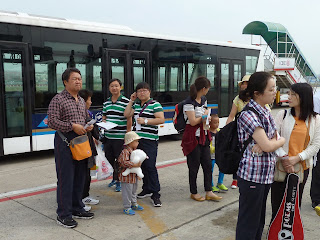
























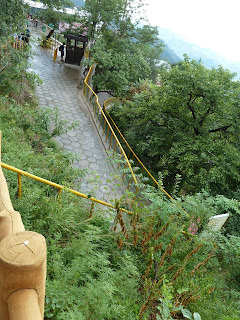




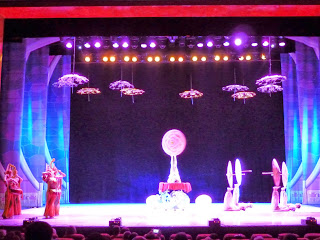
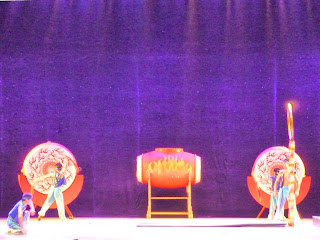













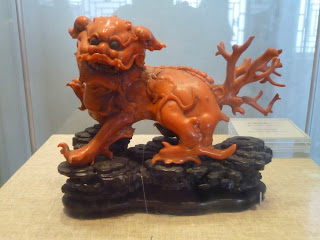






No comments:
Post a Comment